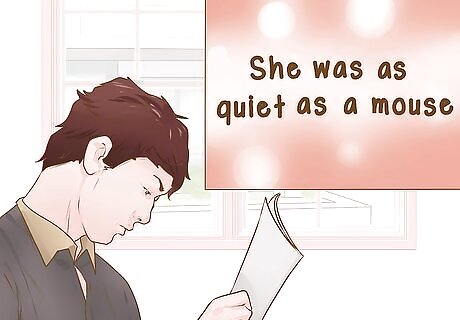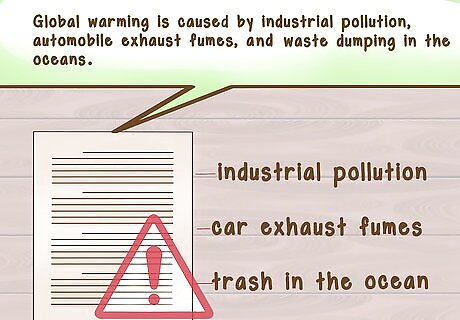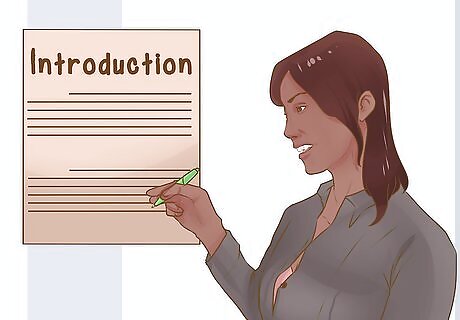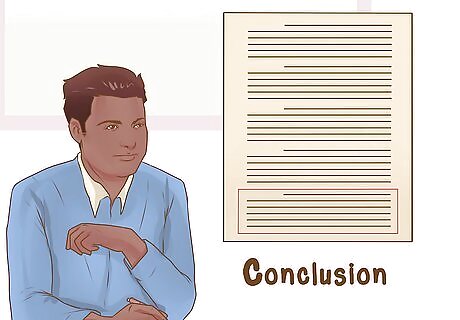
views
Understanding the Format

Understand the purpose of a language analysis. The purpose of this type of essay is to identify the persuasive rhetorical devices used by an author of a specific piece of writing. This involves a thorough analysis of many portions of the text that seem to be particularly persuasive. For a language analysis, the text to be analyzed is usually chosen for you by your teacher. So you won't have to panic about choosing an appropriate text to analyze.

Understand the methodology of a language analysis. To prepare yourself to write a language analysis essay, it is crucial for you to fully immerse yourself in the source and uncover all of the moments in the source in which the author is using language to persuade. The effectiveness of this type of essay depends on your ability to parse through the source material and uncover the moments of persuasion present, identify these moments, and explain their effectiveness to the reader. To this end, you must familiarize yourself with different kinds of rhetorical devices and persuasive techniques used by writers.

Understand the desired outcome of a language analysis. In the end, the main reason someone writes a language analysis (other than the fact that the professor assigned it!) is to identify how an author attempts to sway another person or group of people to feel a certain way about a subject through the use of rhetorical persuasive devices. Some common persuasive techniques include logical fallacies and rhetorical appeals (to ethos, pathos, or logos).
Getting Started

Read your source material. Typically, the language analysis assignment includes specific source material in the form of articles or other texts. The first step to writing your language analysis is to read over these thoroughly and make notes. Try an initial scan, followed by a more thorough detail reading. Reading once broadly and another time in detail can help you to define the overall ideas of the article or articles. Then go back and focus on the details you want to use in your language analysis.

Highlight or underline key passages. Identify the places in the text where the author uses persuasive language. You'll need a way to effectively mark these elements to identify the aspects that you want to use. Highlighting is a common way to do this. Taking notes as you go (by highlighting or underlining) will save you a lot of time later when you want to go back to the text for details to support your claims.

Figure out what the persuasive intention of your author is. The point of performing a language analysis is to identify how an author uses language and rhetoric to persuade their readers about a certain idea. Determine what their point of view is so that you more easily identify their rhetorical techniques. Understanding an author's intention and point of view will help you organize your own thoughts and formulate your analysis.
Identifying Rhetorical Language Use

Understand the rhetorical situation. It is essential that you understand all of the factors in the situation surrounding the text you are analyzing. These elements combined form the rhetorical situation of the issue. Rhetorical situations usually involve employing language that is intended to persuade someone toward a particular view or belief. That is why rhetoric is important in a language analysis essay. These types of essays aim to uncover specific language used by authors in order to persuade readers.

Pay attention to word choice. Diction and word choice are very important in language analyses. Authors choose specific words for specific purposes and it is important to be able to identify the differences in meaning that result because of these choices. For example, if an author uses the word terminate to indicate an ending, this has a much more final, definite ending than to simply say that something is finished or came to an end. Choosing this word over others is a deliberate act on the part of the author, one that can be interrogated in a language analysis essay.

Find appeals to ethos, logos, and pathos. These techniques are often implemented in arguments to help persuade the reader to believe the author's opinion. An appeal to ethos is an ethical appeal that emphasizes the reliability or credibility of the author and their sources to prove a point. An appeal to logos is a logical application of evidence that appeals to the readers sense of logic or reason. An appeal to pathos is a rhetorical technique that weighs on people's emotions to sway their opinion one way or another.

Identify logical fallacies. Logical fallacies are errors or weaknesses in an argument. There are many different kinds of logical fallacies, but they all serve the same purpose: to persuade the reader to agree with the author's viewpoint. One example of a logical fallacy is a hasty generalization. This fallacy involves reaching a conclusion before you have gathered adequate evidence on the subject. An example of a hasty generalization would be that all cows are black with white spots because you've seen three cows and all three of them were black with white spots. Another example of a logical fallacy is a slippery slope argument. This fallacy involves arguing that if one event is allowed to happen, it will inevitably lead to an extreme and undesirable result. An example of a slippery slope argument would be: If we allow one hotel to be built on the lake, pretty soon the whole place will be worse than Las Vegas.

Uncover metaphors. Metaphors directly compare two things based on similarities by equating them as the same. In his play As You Like It, William Shakespeare’s Jacques famously says, All the world's a stage, / And all the men and women merely players: / They have their exits and their entrances. This is a metaphor that compares the action of real life with the action of a theatrical play. Shakespeare says that world is a stage and all the people are actors, not merely that they are like actors.

Find analogies. Analogies are comparisons between two things that intend to help the reader understand a situation or event. Usually, authors compare a known thing with a lesser known thing to help the reader understand the lesser known thing. Unlike metaphors that compare a thing by saying it is another thing, analogies say that something is like something else. For example, saying she was as quiet as a mouse is an analogy that lets the reader know something about the subject, she, by relating a fact about her to a fact everyone knows (that mice are quiet).
Writing Your Analysis

Come up with a thesis statement. Your thesis statement will be a concise idea that sums up your author's view/claim in the work you are analyzing. The thesis usually appears at the end of the introduction paragraph. Having this idea in mind early on in the reading process will help guide your reader through the rest of your essay paper. A good thesis statement is concise and clear. It tells the reader what the point of the paper is and why it's important. The thesis must make a claim of some sort. For this type of essay, your thesis claim will probably be something like this: Through his use of ______ (whatever rhetorical technique you think your author employs), this author attempts to _______ (whatever you think the purpose of his persuasion is). Here is an example of a strong thesis statement: Excessive meat consumption in America is the leading cause of pollution today, and, thus, is a significant influence on global warming. This thesis makes a claim (specifically a cause and effect claim) about a debatable topic with a narrow enough focus to create an interesting, manageable argumentative essay. Here is an example of a weak thesis statement: Pollution is a problem in the world today. This is not a debatable issue; few people would argue that pollution is not a problem. The topic is also too broad. You can't write a paper on every single aspect of pollution.

Avoid the standard three-part thesis often taught to beginning writers. This format is constricting and limits the shape your ideas can take to being contained in three basic body paragraphs. Without the three-part thesis statement, your ideas can expand more freely and incorporate ideas that might not fit exactly into the three parts. An example of a three-part thesis statement might look something like this: Global warming is caused by industrial pollution, automobile exhaust fumes, and waste dumping in the oceans. In this case, you would expect to find three body paragraphs: one about industrial pollution, one about car exhaust fumes, and one about trash in the ocean. Any other causes of pollution would not fit anywhere in this essay, which restricts the meaning and the message of the paper. Changing the thesis to avoid this form will make for a much more functional essay that is written at a more advanced level. A more effective thesis would be something like this: Due to increasing global temperatures and rising ocean levels, global warming has become an issue that needs to be acknowledged by a wider audience in order to begin reversing the effects.

Write an introduction. This section should briefly explain the essay topic and include relevant background information to familiarize the reader with the topic. As previously mentioned, your thesis statement should typically appear at the end of the introduction. A good introduction should give enough background information that the reader feels intrigued and knows what to look for in the rest of the paper.

Write the body of the paper. Carefully present information that supports your thesis claim that this author is utilizing certain rhetorical techniques to achieve a certain goal. Outline each instance where you see this happening and explain your logic/reasoning to your readers. Identify the purpose of your essay (why it's important to understand the author's rhetorical appeals) and the point of the text being analyzed (why the author wanted to persuade their audience to begin with).

Write a conclusion. The aim of this section is to reassert your argument and persuade the audience to support your claim. Try to connect the essay topic to the interests and values of the audience. Be sure to review your main points and restate your thesis. But make sure not to introduce any new information in the conclusion so that you can effectively wrap up what you've already said.
Revising and Applying Final Touches

Take a step back. Often, it's possible to get so wrapped up in your own writing that it's easy to skip over obvious errors and mistakes. Take a break from writing for at least a few hours. Sometimes leaving your work for a couple of days can be incredibly beneficial as well. Looking at your work with fresh eyes will allow you to see the errors you previously overlooked because you were so involved in the writing that you could only see what you meant to say rather than what you actually said.

Create a catchy title. Developing a creative, original title is a fantastic opportunity to hook your readers into wanting to read more of your paper before they even get to the introduction. Writing it after you have completed your essay adds a bit of polish and helps you encapsulate the entirety of your argument.

Revise your essay. Re-read the assignment (if you were given a handout), then re-read your essay. Be sure that your argument flows, that you prove the thesis you set out to prove with solid textual evidence, and that you are doing everything that the assignment asked of you.

Edit for grammar issues. Problems with grammar can make your paper look sloppy and unprofessional. Here are some of the most common grammar mistakes: Sentence fragments. Fragments are incomplete phrases that cannot stand alone as a sentence because they are missing either a verb, a noun, or a complete thought. Parallelism. Errors in parallelism occur when words or groups of words do not appear in the same format or structure within a sentence. Subject-verb agreement. Errors with subject-verb agreement happen when an incorrect verb form is used with a particular subject. For example, he know instead of he knows.

Check for problems with formatting or quote incorporation. If you use sources, formatting quotes properly allows your reader to easily find the information you are referencing. It also adds to your credibility as an author.


















Comments
0 comment